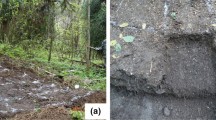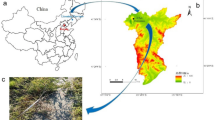Abstract
Aims
This study aims to comprehensively examine the shear behavior of rooted soil mixtures at both macroscopic and microscopic levels.
Method
The research utilizes the discrete element method (DEM) to investigate the shear behavior of rooted soil mixtures through two-dimensional biaxial tests conducted under the membrane boundary condition. The samples were meticulously prepared, with variations in both the volume fraction of roots and soils. The roots were modeled as multiple bonded rigid blocks, enabling them to undergo deformation when subjected to external forces.
Results
From a macroscopic perspective, the rooted samples display deviatoric stress and volumetric strain curves that illustraY. Huangte the stress-strain relationship during shearing. On a microscopic level, the coordination number (representing the contact number per particle) of the rooted soil samples, along with the anisotropy of contact force orientations, serves as valuable descriptors of the evolving microstructures during shearing. Furthermore, the formation of shear bands exhibits variations depending on the content of roots within the samples.
Conclusions
The study findings demonstrate that the macroscopic behavior of rooted soils is influenced by multiple factors, including the volume fraction of the mixtures, stiffness, and aspect ratio of soil particles and roots. These findings highlight the intricate and interdependent nature of the mechanical properties within the root-soil mixture. Additionally, it is observed that a higher volume fraction of roots results in a more complex formation of shear bands, further indicating that the mechanical response of the root-soil mixture is significantly influenced by the presence of roots.
















Similar content being viewed by others
Data availability
The data that support the findings of this study are available from the corresponding author upon reasonable request.
References
Belheine N, Plasslard JP, Donze FV, Darve F, Seridi A (2009) Numerical simulation of drained triaxial test using 3d discrete element modeling. Comput Geotech 36(1–2):320–331
Bishop AW (1971) Shear strength parameters for undisturbed and remoulded soil specimens. Proc Roscoe Memorial Symposium. Cambridge 3–58
Boldrin D, Leung AK, Bengough AG (2020) Hydro-mechanical reinforcement of contrasting woody species a full scale investigation of a field slope. Geotechnique 71:970–984
Bourrier F, Kneib F, Chareyre B, Fourcaud T (2013) Discrete modeling of granular soils reinforcement by plant roots. Ecol Eng 61P:646–657
Chabannes M, Becquart F, Diaz EG, Abriak NE, Clerc L (2017) Experimental investigation of the shear behaviour of hemp and rice husk-based concretes using triaxial compression. Constr Build Mater 143:621–632
Chen H, Zhao SW, Zhou XW (2020) Dem investigation of angle of repose for super-ellipsoidal particles. Particuology 50:53–66
Ciantia M, Arroyo M, Calvetti Gens A (2016) A numerical investigation of the incremental behavior of crushable granular soils. Int J Numer Anal Methods Geomech 40(13):1773–1798
Cundall PA, Strack ODL (1979) A discrete numerical model for granular assemblies. Geotechnique 29:47–65
Dai BB, Yang J, Zhou CY, Luo XD (2016) Dem investigation on the effect of sample preparation on the shear behavior of granular soil. Particuology 25:111–121
Gan JQ, Yu AB (2020) Dem study on the packing density and randomness for packing of ellipsoids. Powder Technol 361:424–434
Gan JQ, Yu AB, Zhou ZY (2016) Dem simulation on the packing of fine ellipsoids. Chem Eng Sci 156:64–76
Ghafghazi M, Shuttle D (2009) Confidence and accuracy in determination of the critical state friction angle. Soils Found 49(3):391–395
Gu XQ, Huang MS, Qian JG (2014) Discrete element modeling of shear band in granular materials. Theor Appl Fract Mech 72:37–49
Gu XQ, Yang J (2013) A discrete element analysis of elastic properties of granular materials. Granul Matter 15(2):139–147
Guo Y, Wassgren C, Hancock B, Ketterhagen W, Curtis J (2015) Computational study of granular shear flows of dry flexible fibres using the discrete element method. J Fluid Mech 775:24–52
Itasca (2019) PFC 6.0 Documentation
Iwashita K, Oda M (1998) Rolling resistance at contacts in simulation of shear band development by dem. J Eng Mech 124(3):285–292
Kawamoto R, Ando E, Viggiani G, Andrade JE (2018) All you need is shape predicting shear banding in sand with ls-dem. Journal of the Mechanics ans Physics of Solids 111:375–392
Li YJ, Zhang Q, Hua X, Guo Y, Curtis J (2022) Fiber reinforcement on spherical granular beds under triaxial compressions. Powder Technol 411(117928)
Lotfalian M, Nasiri M, Modarres A, Wei W (2019) Slope stability analysis considering weight of trees and root reinforcement. J Environ Eng Landsc Manag 27(4):201–208
Lu YE, Tan Y, Li X (2018) Stability analyses on slopes of clay-rock mixtures using discrete element method. Eng Geol 244:116–124
Schwarz M, Rist A, Cohen D, Giadrossich F, Egorov P, Buttner D, Stolz M, Thormann J (2015) Root reinforcement of soils under compression. J Geophys Res Earth Surf 120:2103–2120
Mairhofer S, Johnson J, Sturrock CJ, Bennett MJ, Mooney SJ, Pridmore TP (2016) Visual tracking for the recovery of multiple interacting plant root systems from x-ray uct images. Mach Vis Appl 27:721–734
Masi EB, Segoni S, Tofani V (2021) Root reinforcement in slope stability models a review. Geosciences 11(212)
Murgia I, Giadrossich F, Mao Z, Cohen D, Capra GF, Schwarz M (2022) Modeling shallow landslides and root reinforcement a review. Ecol Eng 181(106671)
Osman N, SSB (2006) Parameters to predict slope stability-soil water and root profiles. Ecol Eng 28(1):90–95
Neto C, Cardigos P, Oliveira SC, Zezere JL (2017) Floristic and vegetation successional processes within landslides in a mediterranean environment. Sci Total Environ 574:969–981
Ni JJ, Bordoloi S, Shao W, Garg A, Xu GZ, Sarmah AK (2020a) Two-year evaluation of hydraulic properties of biochar-amended vegetated soil for application in landfill cover system. Sci Total Environ 712(136486)
Ni JJ, Ng CWW, Gao YF (2020b) Modelling root growth and soil suction due to plant competition. J Theor Biol 484(110019)
O’Sullivan C (2011) Particulate Discrete Element Modelling. CRC Press
Sadrmanesh V, Chen Y (2018) Simulation of tensile behavior of plant fibers using the discrete element method. Compos A 114:196–203
Stokes A, Atger C, Bengough AG, Fourcaud T, Sidle RC (2009) Desirable plant root traits for protecting natural and engineered slopes against landslides. Plant Soil 324:1–30
Sun WC, Wu K, Liu SY, Zhang X (2022) Influence of aspect ratio and arrangement direction on the shear behavior of ellipsoids. Particuology 70:82–94
Switala BM, Wu W (2018) Numerical modelling of rainfall-induced instability of vegetated slopes. Geotechnique 6:481–491
Tamas K, Bernon L (2021) Role of particle shape and plant roots in the discret element model of soil sweep interaction. Biosyst Eng 211:77–96
Wu K, Liu SY, Sun WC, Remond S (2020) Dem study of the shear behavior and formation of shear band in biaxial test. Adv Powder Technol 31:1431–1440
Yang DM, Sheng Y, Ye JQ, Tan YQ (2010) Discrete element modeling of the microbond test of fiber reinforced composite. Comput Mater Sci 49(2):253–259
Yang NY, Chen XB, Li RD, Zhang JQ, Hu H, Zhang JS (2021) Mesoscale numerical investigation of the effects of fiber stiffness on the shear behavior of fiber-reinforced granular soil. Comput Geotech 137:104259
Yang X, Long LH, Evans TM, Zhou H, Liu HL, Stuedlein AW (2019) Effect of particle shape on stress-dilatancy responses of medium-dense sands. J Geotech Geoenviron 145(2):04018105
Zhou W, Yang LF, Ma G, Xu K, Lai ZQ, Chang XL (2017) Dem modeling of shear bands in crushable and irregularly shaped granular materials. Granul Matter 19:25
Zhu MY, Gong GB, Xia J, Liu LF, Wilkinson S (2021) Effects of deviator strain histories on liquefaction of loose sand using dem. Comput Geotech 136(104213)
Acknowledgements
We gratefully acknowledge the financial support provided by the National Natural Science Foundation of China NO. 51978159, NO. 51608112, and the Fundamental Research’Funds for the Central Universities NO.2242023K40018.
Author information
Authors and Affiliations
Corresponding author
Ethics declarations
Conflicts of interest
Disclosure of potential conflicts of interest: The authors declare that they have no conflict of interest.
Additional information
Responsible Editor: Kenneth Wilhelmus Loades.
Rights and permissions
Springer Nature or its licensor (e.g. a society or other partner) holds exclusive rights to this article under a publishing agreement with the author(s) or other rightsholder(s); author self-archiving of the accepted manuscript version of this article is solely governed by the terms of such publishing agreement and applicable law.
About this article
Cite this article
Huang, Y., Ding, J., Sun, W. et al. Evaluating the shear behavior of rooted soil by discrete element method simulations in two dimensions. Plant Soil 493, 355–373 (2023). https://doi.org/10.1007/s11104-023-06234-w
Received:
Accepted:
Published:
Issue Date:
DOI: https://doi.org/10.1007/s11104-023-06234-w




